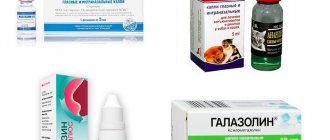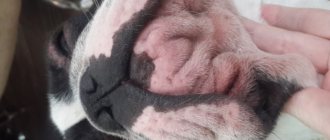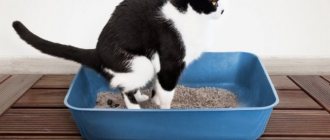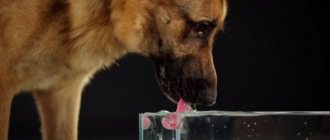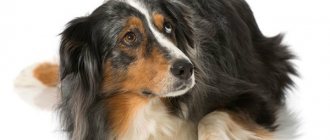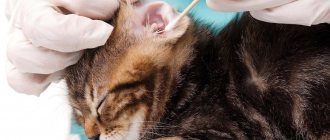Why does my dog have a dry and hot nose?
Most pet owners say that dry mucous membranes indicate that the dog is not feeling well. Most likely, he is unwell and in poor condition. In fact, this is not true; you cannot judge a dog’s health just by the condition of its nose.
Why does a dog have a dry and hot nose:
- High temperature outside
- Dog mobility, playing and running outside
- Lack of water
- Individual structural features of the dog
When to worry
One of the first symptoms indicating some kind of illness or illness in your pet is a dry and hot nose. However, do not forget that the body temperature of cats differs from the human norm and ideally equals 38-39 °C. The animal may be completely healthy, but the lobe will feel hot.
Signs indicating that the cat is still sick may include the following:
- Copious discharge flows from the nose, ears burn. Symptoms indicate the presence of an infection, such as rhinotracheitis or panleukopenia.
- Too wet nose, elevated body temperature, sneezing, lack of appetite. Perhaps there is a cold or acute respiratory viral infection.
- Copious discharge from the nasal cavity, containing blood or purulent inclusions. The possibility of some foreign object getting into the nasal passage cannot be ruled out.
- Excessive mucus discharge from the nose may be an allergic reaction to household chemicals, pollen, tobacco smoke, medications, or house or street dust.
- The lobe is very wet, and the cat itself sniffles heavily and breathes mainly through its mouth. Such symptoms may indicate the presence of a polyp and damage to the mucous membrane inside the nasal cavity.
- A wet and very cold nose indicates hypothermia or poisoning.
You can also judge the presence of health problems by the color of your nose. Thus, a bluish tint, as a rule, is a consequence of disorders in the cardiovascular system. Yellow almost always gives a “hint” to problems with the kidneys or liver. White indicates changes in the functioning of the circulatory system.
Why does a dog have a dry nose? Reasons
Accordingly, in order to find out whether a dog is sick with something or not, it is necessary not only to evaluate the dryness of the tip of the muzzle, but also how he feels in general, there are no suspicious symptoms. If a pet suffers from vomiting, is restless, does not eat well, but its mucous membranes are wet, this is a sign of a disease, so you should not focus only on the moisture content of the tip of the muzzle.
Why does a dog have a dry nose, reasons:
- Oddly enough, our pets can suffer from allergies, just like people. Accordingly, in early spring, when plants are just beginning to bloom, the dog may experience dry mucous membranes. There may not be any additional symptoms.
- Most often, it is precisely because a wet nose attracts all sorts of allergens that it becomes dry to maintain health. It is necessary to pay attention to the weather, not only hot, but also cold. In frosty times, when there is a strong squall wind, the pet’s mucous membranes are dry and warm. This is due to the fact that a wet nose can become covered with an icy crust; therefore, the drying of the secretion in such conditions is a natural phenomenon in order to protect the dog from various ailments.
- Allergies in dogs can be caused not only by plant pollen, but also by some objects used in the feeding process. These can be bowls, as well as rodents made from low-quality silicone or plastic. Both people and dogs can be allergic to cheap Chinese plastic.
Cutie
What does it mean if a dog has a dry nose?
If the pet is cheerful, feels good, does not refuse food and walks, and is generally playful and happy, then dry mucous membranes should not cause fear, doubt or worry. Most likely, everything is fine with your pet. Typically, the mucous membrane dries out in most dogs in hot weather, when it is very hot, there is not enough moisture.
Nowadays this happens mainly in dogs that are kept outside, and sometimes they forget to add water. Often it is the lack of water that causes dry mucous membranes. This indicates that the dog is in the early stages of dehydration, which is why the mucous membranes are drying out. What does it mean if a dog has a dry nose? In hot weather, if your dog has a dry nose, be sure to provide an additional container of water.
Cute pet
Nose
The keratinizing cells lining the nose are pigmented in most dogs. The color of the nose depends on the color of the dog. As a rule, the color of the nose is the same as the color of the eyelids, lips and paw pads.
At birth, puppies can have a different color of the nose from pink to black; later this color can change in one direction or the other.
Black nose Akita Inu
Black is the most common nose color in dogs and is required by most breed standards.
Liver (brown) - observed in dogs of brown and isabella color. In this case, usually the color of the lips and eyelids is also brown. Brown pigment does not seem to stay in the nose as easily as black pigment, which is why many brown dogs with a significant amount of white spotting in their coat have a completely pink nose. It is genetically impossible for brown dogs to have a black or blue nose.
Gray (steel, slate, blue) color of the nose is found in dogs of blue color (for example, American Staffordshire Terrier, Great Dane).
Beige
Labradoodle's butterfly nose. Photo source
Butterfly nose (spotted nose, marbled nose, butterfly nose, parti nose) - a partially unpigmented nose with irregularly shaped spots. These spots are randomly located and can occupy any area of the nose, from a tiny pink spot to almost the entire nose. Butterfly noses are sometimes found in dogs with extreme white spotting (such as white boxers, bull terriers and Dogo Argentinos), but more commonly the butterfly nose is associated with merle. However, not all merles have a butterfly nose—double merles and merles with few dark spots are more prone to them, and it is also very common among Great Danes and Harlequins. This is an undesirable trait in most breeds. Depigmented areas of the nose may become sunburned.
Dudley nose . Unfortunately, there is no exact definition of the term dudley, because... in different situations and breeds it means completely different concepts. H.R. Spira gives the following definition: “the name given to a weakly pigmented flesh-colored nose” and cites “cherry nose”, “yellow-gray nose” and “flesh nose” as synonyms. The AKC defines a dudley as a "flesh-colored nose" (not pink!). However, another definition is often found - it is a brown-pink nose, also called “red nose” (in the American Pit Bull Terrier) or “liver”. It is not always clear what kind of pigmentation the eyelids and skin around the nose should be (or possible) - somewhere they talk about black, somewhere about the same flesh-colored (liver).
Most often, the term "Dudley nose" is used to describe a dog with loss of pigment on the nose. Typically, pigment loss on a Dudley's nose occurs in the middle of the nose, spreading outward to cover almost the entire nose in some dogs. The loss of pigment causes the nose in these areas to become lighter in color, usually a dull pink. A Dudley's nose never completely loses its pigment and is never as bright pink as a butterfly nose or even the pink nose of brown dogs. There is also always a darker area around the edge of the nose.
There are several versions about the origin of this term. Some claim that the term "Dudley" originated in 1877 from the English bulldog Lord Dudley, who had a liver-colored nose and lips. Rawdon B. Lee in the book “A history and description of the modern dogs of Great Britain and Ireland” (Non-sporting division) in the section on bulldogs indicates that dogs with a flesh-colored nose, light eyes and generally with a yellowish muzzle, are called "Dudleys" because these animals originally come from Dudley (West Midlands, UK). Later the term began to be used for other breeds. [4]
Labrador Dudley is a fawn Labrador with brown pigmentation on the nose and eyelids. Photo source
In the Labrador breed, "Dudleys" are fawn-colored dogs with chocolate nose pigmentation. However, this term also applies to Labradors that do not have any pigmentation on the nose and area around it, as well as on the eyelids, i.e. all pink (LRC) [2]. Sometimes in some breeds, such as the Bull Terrier, the term "Dudley nose" is used to describe a dog with a pink nose due to a significant amount of white spotting on the face (see "butterfly nose" above).
Veterinarians and some breeders [1, 3] use the term “dudley” (or idiopathic nasal depigmentation) to refer to a nose that loses pigmentation over time. Those. a puppy might have a black, well-pigmented nose, but by adulthood it becomes flesh-colored or pink and subsequently no longer changes color (unlike the “winter nose”). The causes of this phenomenon include vitiligo, allergies, liver disease and hormonal disorders. However, Dudleys are generally considered to be a purely cosmetic defect. There is also talk of a genetic predisposition to Dudley in some breeds (Labrador, German Shepherd, Afghan Hound, Irish Setter, Poodles, etc.).
In most breed standards, such nose pigmentation is a defect (for example, in the English bulldog, Labrador retriever). However, in some breeds it is acceptable (American Pit Bull Terrier).
Snow nose (or winter nose) on a golden retriever
Winter nose (snowy, dirty) is a temporary (unlike Dudley) weakening of the pigmentation of the nose in some dogs during the winter-spring period, and also sometimes after whelping, stress or illness. Possible in any dog - with a black, brown, gray nose, with a partially depigmented or poorly pigmented nose. The winter nose does not depend on coat color. It is found in breeds such as Labrador Retriever, Siberian Husky, Bernese Mountain Dog, etc. The exact cause of this phenomenon has not been established; there are versions of group B vitamin deficiency, lack of zinc and iodine, as well as lack of sunlight (or ultraviolet radiation). Sometimes replacing the dog's plastic bowl, which can rub his nose on, helps correct the situation. It should not be confused with nasal depigmentation associated with vitiligo.
A reddish (“pheomelanistic”) nose is a consequence of the complete disappearance of eumelanin under the influence of its alleles; thus it is clearly associated with the red coloration. Allowed in some breeds. It should not be confused with the pink lobe. It is sometimes called flesh-colored, which can cause confusion with a pink nose.
A lightened nose is allowed in some breeds (for example, South Russian Shepherd Dog, Central Asian Shepherd Dog).
Pink color - depigmented nose. In most breeds it is considered a defect, including because depigmented skin does not provide protection from the sun. It occurs only in combination with white spotting in color and is explained by the spread of depigmentation to the nose area. Breeds that work outdoors during the day, such as hunting and herding breeds, are more likely to have a standard stating that lack of nose pigmentation is a fault. Sometimes (for example, in the Ibiza Greyhound) this trait is regarded as desirable, but in other breeds it is rejected in the vast majority of cases.
Trauma to the nose can sometimes lead to loss of pigment, either permanent or temporary. Some diseases such as vitiligo, autoimmune diseases and neoplasms can lead to depigmentation of the nose.
Why does my dog have a cold and dry nose?
If a dog has been in a fight or has wounds or ulcers on its body, then dry mucous membranes are common. This means that the dog has experienced severe stress, he has some damage, so the body is trying to mobilize and not waste extra energy on moisturizing the mucous membrane. Please note that if your dog has a cold and dry nose, he most likely has the early stages of a cold. A little later, the dog may start coughing and sneezing. In this case, it is necessary to give medications and provide good care, as well as proper feeding.
If the dog lives in an apartment, then dry mucous membranes can be observed if the heating radiators are heated in the house, and the humidity level is very low. If your home has air conditioning, or it's the heating season, it's time to buy a humidifier. This will be useful not only for the residents of the house, people, but also for pets, including cats and dogs.
The dog is sick
Why is my dog's nose wet and cracking?
Please note that in babies, that is, puppies, immediately after birth, the thermoregulation system has not yet been established, so they may have a dry nose. Over time, when the puppy grows up, everything will return to normal. Why do doggies usually have moist mucous membranes? This is due to the fact that the tip of the muzzle serves not only as a sense of smell, but also as a radar, which is used to navigate in space. This function is also performed by the mustache located at the tip of the muzzle.
Why does a dog's nose become wet and cracked?
- This is necessary to ensure good sensitivity and excellent spatial orientation. The top of the nose is wet because it is covered with special mucus, the composition of which is very similar to that of humans.
- In dogs, mucus spreads not only to the inside of the nose, but also to the outside. In addition, the tip of the nose contains a lot of nerve endings and blood vessels, the integrity of which is maintained by a moist environment and a special mucous secretion.
- Therefore, if a dog is deprived of this moisture, it may feel unwell and be less able to navigate in space. This carries some danger for the pet, since it loses its senses by about 50%.
- With the help of this important film, the air that enters the dog's respiratory tract is heated or further cooled depending on weather conditions.
Cheerful dog
Norm or pathology
When a person is healthy and does not have chronic pathologies of the nose, for example, rhinitis (inflammation of the turbinates), he will not have nasal discharge in the cold, at most they will appear in a small amount, for which even a scarf is not required.
But in situations where a person has a deviated septum or a chronic runny nose, frequent nasal discharge in large volumes may well occur. Also, allergy sufferers constantly face a similar situation: they have increased sensitivity of the nose, and when an allergen gets in, a protective reaction begins, aimed at getting rid of it, as a result of which the production of mucus in the nose increases.
If you experience a large amount of fluid flowing from your nose, you should not relax, resign yourself, take a mountain of tissues with you and feel sorry for yourself. You should see an otolaryngologist who will prescribe proper treatment. This situation indicates that the shells are unhealthy, for example, inflamed.
Article on the topic
Problems on the nose. How to blow your nose correctly and treat a runny nose? The doctor will carry out his manipulations to reduce inflammation of the turbinates and propose a specific treatment plan, as a result of which the functions of the nose will be restored. If we are talking about a deviated septum, then other methods must be used. Which ones exactly, the specialist will tell you.
As soon as the tone of the turbinates is restored, they will no longer react as much to temperature changes and will not produce mucus as actively.
Why does my dog have a dry nose and no appetite?
Some dogs, due to their individual characteristics of the body, may also be characterized by dry mucous membranes and its high temperature. However, in most cases, veterinarians sometimes recommend moisturizing the nose of such pets using special drops, as well as antibacterial compounds. If a dog has a dry nose and no appetite, it becomes vulnerable to various microorganisms and bacteria. Dogs with a dry nose are more likely to catch some kind of infection and get sick faster.
As you can see, it is necessary to monitor the dog’s condition, including the dryness of the nose, as well as its temperature. Very often, dry and mucous membranes become the first symptom of a serious illness. This should cause concern to the owner and increased interest in his four-legged friend.
Nature radar
